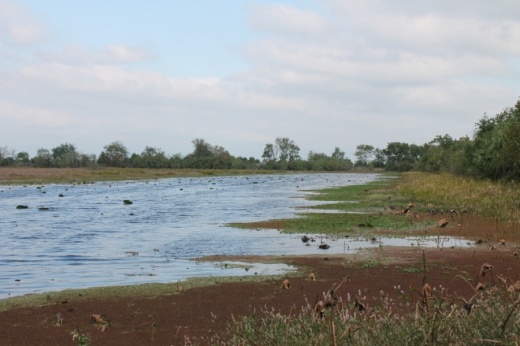As the Army Corps of Engineers continues to study flood mitigation options for the Buffalo Bayou, Addicks Reservoir and Barker Reservoir watersheds, officials with the Katy Prairie Conservancy said they and a coalition of other stakeholders are urging the Corps to reassess its early findings.
The Corps released an interim report in early October that put several possible solutions up for public comment. Two concepts that have emerged as early contenders involve building a 190,000-acre-foot reservoir on Katy prairie land. Downstream of the Addicks and Barker reservoirs, the Corps is also looking into the possibility of deepening and widening Buffalo Bayou.
MaryAnne Piacentini, president of the nonprofit Katy Prairie Conservancy, has expressed concern about using prairie land for a reservoir in the past, arguing that the reservoir would disrupt the life cycles of various species, that the land already provides flood control benefits and that other concepts would make more sense from a cost-benefit standpoint as well. She said was surprised to see the Cypress Creek reservoir concept still under consideration at this point in the process.
"It appeared from the initial analysis that the Cypress Creek reservoir would not be one of the chosen alternatives," she said. "That it did not seem to have enough cost-benefit [and] it might take too much time to do."
The KPC is among several groups—along with the Houston Parks Board and the Cypress Creek Flood Control Coalition—that is asking the Army Corps to extend its public comment period from Nov. 2 to Dec. 31 and to provide more data on how it reached the conclusions laid out in the interim report. Corps officials have emphasized that no official recommendations or rankings have been made yet and that nothing is set in stone.
In its interim report, the Army Corps detailed some of the adverse effects the reservoir concept would have on prairie land if built. The reservoir would "significantly alter and degrade more than 75% of the remaining range-wide Katy Prairie habitat and a significant portion of the actively managed and preserved remaining habitat," according to the report.
Having the land inundated with water at seasonably unpredictable times would disrupt the life cycles of protected plants and animals, Piacentini said. Many plants cannot withstand inundation for extended periods of time, which would result in a decline in plant and soil biodiversity over time, she said.
Based on what she has observed in the public feedback process, Piacentini said the proposals in the interim report largely seemed to lack public support. She said the KPC and others have devised a four-pillar alternative plan that they are hoping the Corps takes into consideration as the study continues.
- Work in the upper Cypress Creek watershed including: expanding the Katy prairie; having the HCFCD acquire detention rights on private land through voluntary agreements with landowners; making channel improvements to improve storage along Cypress Creek and South Mayde Creek; and developing a series of smaller reservoirs in upper Addicks Watershed
- Expand the capacities of the Addicks and Barker reservoirs
- Strengthen the dam to ensure no spillover
- Improve conveyance along Buffalo Bayou, possibly through use of an underground tunnel
"We are surprised the [Army Corps] screened that out," Piacentini said. "We are heartened that the [flood control] district believes that it can still be studied and should be studied."
Piacentini also acknowledged the challenges of expanding the reservoir capacities, but said she believed there is potential for the capacity to be doubled.
"There are some environmental concerns, and we need to look at those," she said. "But we think this can be done by using discretion as to where you dig, and maybe the places that are a little more precious would be protected from excavation."
Piacentini said she is hopeful the Corps will extend the comment period and is cautiously optimistic that they will take the four-pillar plan into account moving forward as the modeling and analysis continues. She said it is crucial for the Amry Corps to remain involved with the project due to the sheer scope and cost of what needs to be done.
"None of these things are easy," Piacentini said. "We understand that this is a very difficult problem to solve and we understand that there may be some issues with each [solution]. I think the good news is the environmental community is starting to work with the engineering community and the business community to look at problems together."
No matter how the Corps moves forward, Piacentini said she will work to protect the prairie land.
"We have responsibility to protect that land permanently; it’s supposed to be forever," she said. "We’re going to do everything we can to protect our land, but we’re also going to do everything we can to work with the community to let them know there’s a better way to do this."
Public comments can continue to be submitted here through Nov. 2, pending a possible extension in the public comment period. A fourth and final hearing for public comments will be held virtually from 1-3 p.m. on Oct. 26.





